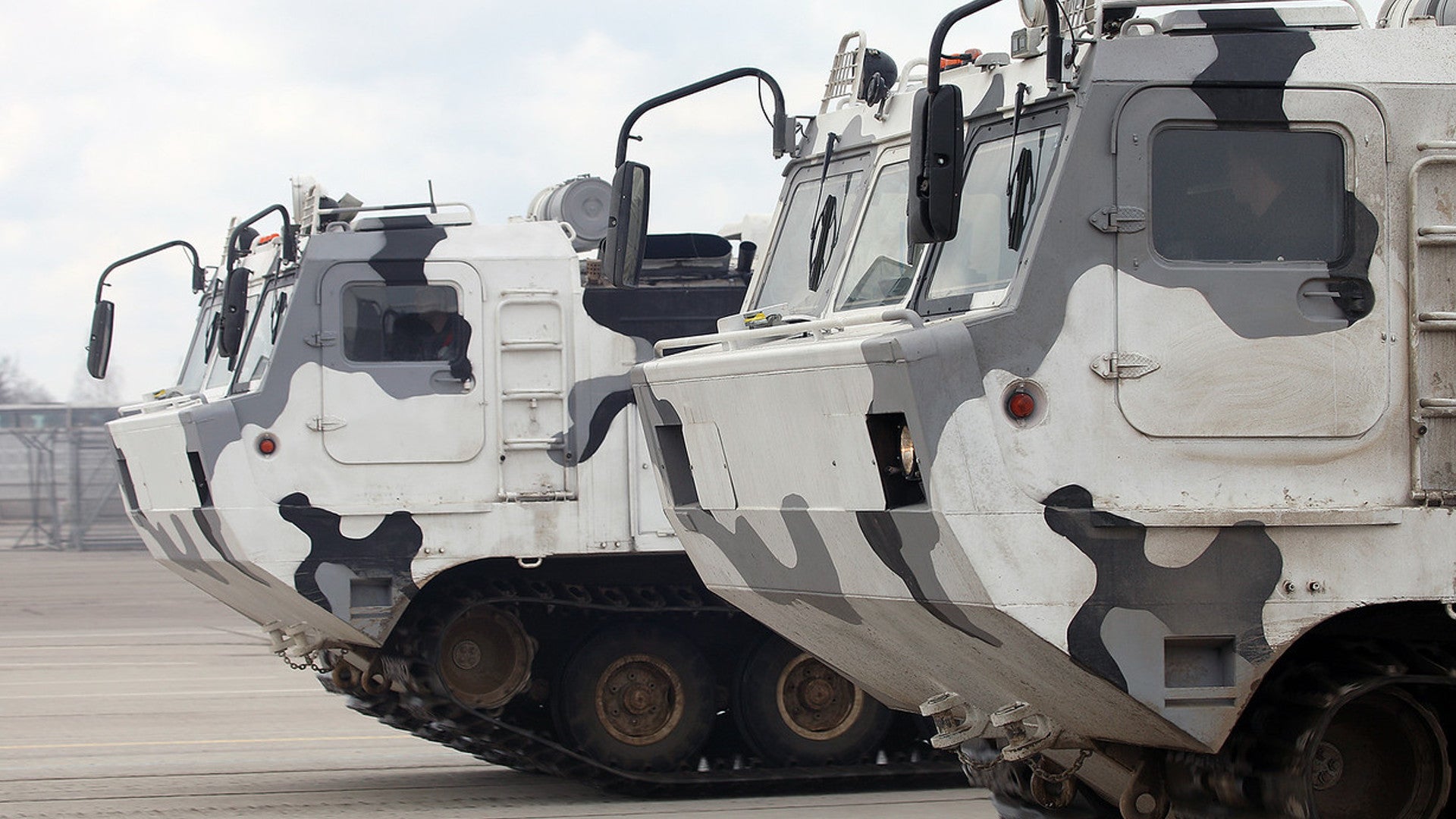It’s no secret that Russia is building up its forces for combat north of the Arctic Circle and we have previously explored how the frigid wastes are increasingly a point of contention between officials in Moscow and their counterparts in other countries when it comes to territorial claims and resource rights. Now, the Kremlin has revealed it is building mobile anti-aircraft defenses specifically for its troops in the region.
On April 5, 2017, photographer Vitaly Kuzmin spotted the two air defense systems as they prepared at the Alabino Proving Ground outside Moscow for Russia’s annual Victory Day parade. The event commemorates the country’s capture of Berlin and defeat of Nazi Germany in 1945 and has historically been an opportunity to show off new military hardware.
In this case, among the participants, were units with the 9K331MDT Tor-M2DT and Pantsir-SA systems. Though almost entirely covered in tan tarps to protect their pristine paint jobs for the parade, a distinct winter-themed three color white-black-gray camouflage scheme was visible in the pictures.
More importantly, both are variants of existing systems mounted on the DT-30PM tracked vehicle. A Soviet-era design also known as the Vityaz ATV, the nearly 60-ton carrier has two distinct sections with an articulating linkage connection the drive trains. The PM-variant introduced a new, more powerful engine compared to the older versions.

On improved roads, the DT-30s have a top speed of 30 miles per hour. However, they have excellent mobility off road, even in loose terrain like sand and snow, thanks to the four, wide, powered rubber-band tracks. They are also amphibious, but move at only three miles per hour in water.
In addition, the vehicles can operate in temperatures as low as negative 58 degrees Fahrenheit – the average winter low in the Arctic – and at altitudes as high as 4,000 feet. These features made the DT-series popular with the Russian Army, as well as the country’s natural resources extraction firms, including the state oil company Gazprom.

On both the 9K331MDT Tor-M2DT and Pantsir-SA, the rear module holds the main weapon systems. In the front, retractable antennas on the Pantsir-SA suggest the air defense versions may use the carrier’s compartment for more than just carrying the crew. According to the manufacturers, both systems can take on helicopters, fast-moving fixed-wing aircraft, and cruise missiles at short and medium ranges.
The Soviet-era Tor missile system has been in service since 1986. The weapon consisted of a group of 8 vertical launchers and fire control radar inside a rotating turret. The missiles came in two self-contained four-round “packs” for fast reloading.

Wheeled or tracked carriers could carry the whole setup and the power needed to operate it. At the time, the Soviet Union boasted it could shoot down nuclear-tipped AGM-86 air-launched cruise missiles, even in bad weather.
In 1991, Russia introduced an improved version, the 9K331, also referred to as the Tor M1. This variant had a top speed of Mach 2.5 and a maximum range of just over 9 miles. An improved fire control system could track two targets at once and the missiles had unspecified improvements to make them more resistant to jamming. The weapons were reportedly precise enough to engage small, rockets, as well as aircraft and cruise missiles.

In 2007, missile maker Almaz Antey announced the new M2 variant. The further improved weapon system could now launch missiles at four separate targets at once and crews could fire within seven seconds of spotting a contact on their radar. Based on the nomenclature, the Tor-M2DT should be a subvariant of this version, but able to operate at extremely low temperatures.
Pantsir is a turreted combination gun and missile system. Introduced in 2012, the complete system has six missile launchers and two, twin-barrel 30mm cannons. The 57E-series missiles have a top speed of Mach 2.3 and a maximum range of more than 12 miles, but it has no internal seeker. Instead, crews must steer them to their targets using an active radio command link. The launch vehicle has both radar and a long-range infrared tracking sensor, and can target up to four different enemies at once, depending on the particular variant.

And while they’re intended for anti-aircraft work, Pantsir gunners can turn their guns on ground targets, as well. There is a mix of high-explosive, fragmentation and armor-piercing rounds available for the 2A38M cannons.
Russian state media outlet TASS first disclosed plans for the Arctic-capable Pantsir-SA in February 2015, but only in their Russian-language edition (). The requirement reportedly came after tests showed the wheeled Pantsir-S1 performed poorly in tests. Initial mentions of the 9K331MDT Tor-M2DT began appearing in 2016, amainly on Russian blogs.
Together, the weapons could give Russian troops in the Arctic climate a capable defense against aerial opponents, including both attacking aircraft and airborne forces. Pantsir-SA could provide additional firepower against light-armed opponents on the ground. And why might that be a particularly important statement for the Kremlin to make?

On February 2014, paratroopers from the U.S. Army’s 4th Brigade, 25th Infantry Division parachuted into an Arctic drop zone near Dead Horse, Alaska. This occurred around the same time the Russian military announced plans to create a dedicated command for military operations in the region.
Since then, the brigade’s soldiers have conducted more parachute jumps above and below the Arctic Circle. The Russians have done the same. The most recent American practice session, nicknamed Spartan Pegasus 2017, involved both airborne and airmobile operations. The exercise scenario involved a hunt for a downed satellite.
Whatever the impetus, the appearance of the 9K331MDT Tor-M2DT and Pantsir-SA are another clear reflection of Russia’s stated plans to militarize the Arctic and defend existing and future claims to territory in the region. It might mean other powers with interests north of the Arctic Circle will have to start preparing for more extensive contingencies, too.
Contact the author: joe@thedrive.com
